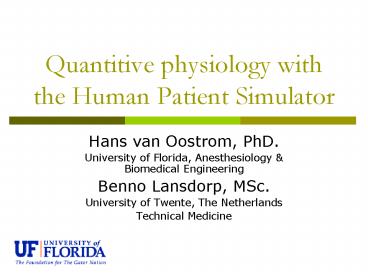Quantitive physiology with the Human Patient Simulator - PowerPoint PPT Presentation
1 / 16
Title:
Quantitive physiology with the Human Patient Simulator
Description:
Starling Curve ... In one graph plot 3 Starling curves from the obtained data and answer the ... drugs do and explain how it caused a difference in the Starling curve ... – PowerPoint PPT presentation
Number of Views:44
Avg rating:3.0/5.0
Title: Quantitive physiology with the Human Patient Simulator
1
Quantitive physiology with the Human Patient
Simulator
- Hans van Oostrom, PhD.
- University of Florida, Anesthesiology
Biomedical Engineering - Benno Lansdorp, MSc.
- University of Twente, The Netherlands
- Technical Medicine
2
Overview
- Introduction
- The essence of teaching physiology
- Demonstration of teaching physiology using
METI-HPS - Starling Curve
- Discussion of using METI-HPS in teaching
physiology, other possible scenarios, your
experience
3
Aims workshop
- Identify and describe the relevance of teaching
physiology to gain insight in the human system - Identify and describe the advantages of using
simulation as a tool for teaching physiology - Develop learning modules based on simulation by
themselves
4
Essence of teaching Physiology
- Knowledge of physiology is essential to
understand the functioning of the human system in
interaction with the supportive technology and
thereby come to innovative solutions - This quantification and modeling help to gain
insight in the complex interrelationships of the
human system
5
Homeostasis (equilibrium nonlinear system)
equilibrium pointanalysis
Two dynamic systems in a loop
Proces 2
Proces 1
equilibriumpoint
Control of equilibrium is essential in many body
processes, e.g. involved in homeostasis
6
Cardiac output is determined by the intersection
of return function and cardiac function
7
Cardiac Output Curve
Sympathetic ?
Heart rate ?
Sympathetic ?
Heart rate ? Myocardial damage
8
Mathematics Cardiac Output
C capacitance, Ddiastole, Ssystole, Praright
atrial pressure, Pplpleural pressure,
PAarterial pressure
9
Venous return curve
Q
Venous cap. ?
Resistance ?
Pra
10
Mathematics of venous return
Pmsmean circulatory pressure, Praright atrial
pressure, Rresistance,C capicitance,
Aarterial, Vveneus
11
Steady-state closed-loop Cardiac output regulation
Contractility ?
normal
4
1
3
Blood volume ?
2
12
Simulation exercise 1
- Design three scenarios to derive the starling
curve from 3 different patients - Normal but hypovolemic patient
- Sick (low CO) patient
- Treated patient (with an Inotrope)
13
Possible solutionTreat by adding volume, record
CVP, HR, CO
14
Simulation exercise 2
- In one graph plot 3 Starling curves from the
obtained data and answer the following questions - Explain the shape of the Normal and Sick curves
- To treat the patient an Inotrope was given. Look
up what inotropic drugs do and explain how it
caused a difference in the Starling curve
15
Other possible simulation topics
- Barorelex
- Respiratory control
- ....
- ..
16
Discussion
- Comments?
- Suggestions?
- Your experience?































